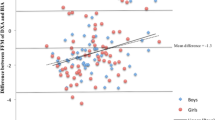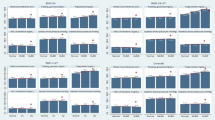Abstract
Objective:
To investigate the relationship between bone mineral density (BMD), anthropometric characteristics, levels of biological markers for growth, bone turnover, insulin resistance and fat mass in 4-year-old Swedish children.
Methods:
Descriptive study with 41 children (28 boys) who had anthropometric measurements and blood samples taken and heel dual-energy X-ray absorptiometry and laser (DXL) performed. The study participants were divided into groups of normal-weight (n=28) and overweight or obese (n=13) children.
Results:
There was a significant difference in bone mineral content (BMC), BMD and bone mineral apparent density (BMAD) between overweight and normal-weight children. There was a significant positive correlation between BMC, BMD, BMAD and body mass index standard deviation scores (r=0.36, 0.34 and 0.29, P<0.01, respectively), waist circumference (r=0.32, 0.30, P<0.01 and r=0.26, P<0.05, respectively) and subscapular skinfold (r=0.26, 0.25 and 0.23, P<0.05, respectively). BMC and BMD correlated significantly with the sum of skinfold measures (r=0.25 and 0.23, P<0.05, respectively). Adiponectin was significantly inversely correlated with BMC, BMD and BMAD (r=−0.41, −0.40 and −0.41, P<0.01, respectively). Adiponectin was not correlated with skinfold measures. Multiple regression analysis revealed that adiponectin was an independent determinant of BMD, BMC and BMAD.
Conclusion:
To our knowledge, this is the first study investigating BMD assessed by heel-DXL in relation to anthropometry and metabolic markers in 4-year-old children. Adiponectin was significantly inversely correlated with bone mass parameters. Adiponectin may have an independent role in bone development and metabolism in young children.
This is a preview of subscription content, access via your institution
Access options
Subscribe to this journal
Receive 12 print issues and online access
$259.00 per year
only $21.58 per issue
Buy this article
- Purchase on Springer Link
- Instant access to full article PDF
Prices may be subject to local taxes which are calculated during checkout

Similar content being viewed by others
References
World Health Organisation. Obesity: preventing and managing the global epidemic. Report of a WHO consultation, Geneva, 3–5 June 1997 (WHO Technical Report Series 894). WHO: Geneva, 2000.
MacKelvie K J, Khan K M, McKay H A . Is there a critical period for bone response to weight-bearing exercise in children and adolescents? A systematic review. Br J Sports Med 2002; 36: 250–257.
Linden C, Ahlborg HG, Besjakov J, Gardsell P, Karlsson MK . A school curriculum-based exercise program increases bone mineral accrual and bone size in prepubertal girls: two-year data from the pediatric osteoporosis prevention (POP) study. J Bone Miner Res 2006; 21: 829–835.
Ahrens W, Bammann K, de Henauw S, Halford J, Palou A, Pigeot I et al. Understanding and preventing childhood obesity and related disorders-6 a European multilevel epidemiological approach. Nutr Metab Cardiovasc Dis 2006; 16: 302–308.
Berner H, Lyngstadaas S, Spahr A, Monjo M, Thommesen L, Drevon C et al. Adiponectin and its receptors are expressed in bone-forming cells. Bone 2004; 35: 842–849.
Roth D . Bones and beyond: an update on the role of vitamin D in child and adolescent health in Canada. Appl Physiol Nutr Metab 2007; 32: 770–777.
Jurimäe J, Jurimäe T . Plasma adiponectin concentration in healthy pre- and postmenopausal women. Am J Physiol Endocrinol Metab 2007; 293: E42–E47.
Ducy P, Amling M, Takeda S, Priemel M, Schilling AF, Beil FT et al. Leptin inhibits bone formation through a hypothalamic relay: a central control of bone mass. Cell 2000; 100: 197–207.
Wang J, Zhou J, Bondy CA . Igf1 promotes longitudinal bone growth by insulin-like actions augmenting chondrocyte hypertrophy. FASEB J 1999; 13: 1985–1990.
Swolin D, Brantsing C, Matejka G, Ohlsson C . Cortisol decreases IGF-I mRNA levels in human osteoblast-like cells. J Endocrinol 1996; 149: 397–403.
Pawley N, Bishop N . Prenatal and infant predictors of bone health: the influence of vitamin D. Am J Clin Nutr 2004; 80: 1748S–1751S.
Lee NK, Hideaki S, Hinoi E, Ferron M, Ahn JD, Confavreux C et al. Endocrine regulation of energy metabolism by the skeleton. Cell 2007; 130: 456–469.
Fledelius C, Johnsen HA, Cloos ACP, Bonde M, Qvist P . Characterization of urinary degradation products derived from type I collagen. J Biol Chem 1997; 272: 9755–9763.
Christgau S, Bitsch-Jensen O, Hanover Bjarnason N, Gamwell HE, Qvist P, Alexandersen P et al. Serum crosslaps for monitoring the response in individuals undergoing antiresorptive therapy. Bone 2000; 26: 505–511.
Harkness L, Bonny A . Calcium and vitamin D status in the adolescent. J Pediatr Adolesc Gynecol 2005; 18: 305–311.
Holick MF . Resurrection of vitamin D deficiency and rickets. J Clin Invest 2006; 116: 2062–2072.
Karlberg J, Luo ZC, Albertsson-Wikland K . Body mass index reference values (mean and s.d.) for Swedish children. Acta Paediatr 2001; 90: 1427–1434.
Kullenberg R, Falch JA . Prevalence of osteoporosis using bone mineral measurements at the calcaneus by dual X-ray and laser (DXL). Osteoporos Int 2003; 14: 823–827.
Söderpalm A-C, Kullenberg R, Albertsson-Wikland K, Swolin-Eide D . Pediatric reference data for bone mineral density in the calcaneus for healthy children 2, 4, and 7 years of age by dual-energy x-ray absorptiometry and laser. J Clin Densitom 2005; 8: 305–313.
Matthews DR, Hosker JR, Rudenski AS, Naylor BA, Treacher DF, Turner RC . Homeostasis model assessment: insulin resistance and β-cell function from fasting plasma glucose and insulin concentrations in man. Diabetologia 1985; 28: 412–419.
Madhusmita M, Miller KK, Cord J, Prabhakaran R, Herzog DB, Goldstein M et al. Relationships between serum adipokines, insulin levels, and bone density in girls with anorexia nervosa. J Clin Endocrinol Metab 2007; 92: 2046–2052.
Jürimäe J, Jürimäe T . Adiponectin is a predictor of bone mineral density in middle-aged premenopausal women. Osteoporos Int 2007; 18: 1253–1259.
Eriksson S, Mellström D, Strandvik B . Volumetric bone mineral density is an important tool when interpreting bone mineralization in healthy children. Acta Paediatr 2009; 98: 374–379.
Whipple T, Sharkey N, Demers L, Williams N . Leptin and the skeleton. Clin Endocrinol 2002; 57: 701–711.
Kontogianni MD, Dafni UG, Routsias JG, Skopouli FN . Blood leptin and adiponectin as possible mediators of the relation between fat mass and BMD in perimenopausal women. J Bone Miner Res 2004; 19: 546–554.
Matkovic V, Ilich JZ, Skugor M, Badenhop NE, Goel P, Clairmont A et al. Leptin is inversely related to age at menarche in human females. J Clin Endocrinol Metab 1997; 82: 3239–3245.
Lenchik L, Register TC, Hsu F-C, Lohman K, Nicklas BJ, Freedman BI et al. Adiponectin as a novel determinant of bone mineral density and visceral fat. Bone 2003; 33: 646–651.
Ağbaht K, Gürlek A, Karakaya J, Bayraktar M . Circulating adiponectin represents a biomarker of the association between adiposity and bone mineral density. Endocrine 2009; 35: 371–379.
Jürimäe J, Rembel K, Jürimäe T, Rehand M . Adiponectin is associated with bone mineral density in perimenopausal women. Horm Metab Res 2005; 37: 297–302.
Huang KC, Cheng WC, Yen RF, Tsai KS, Tai TY, Yang WS . Lack of independent relationship between plasma adiponectin, leptin levels and bone density in nondiabetic female adolescents. Clin Endocrinol 2004; 61: 204–208.
Kindblom JM, Ohlsson C, Ljunggren O, Karlsson MK, Tivesten A, Smith U et al. Plasma osteocalcin is inversely related to fat mass and plasma glucose in elderly Swedish men. J Bone Miner Res 2009; 24: 785–791.
Garnero P, Grimaux M, Seguin P, Delmas PD . Characterization of immunoreactive forms of human osteocalcin generated in vivo and in vitro. J Bone Miner Res 1994; 9: 255–264.
Masters PW, Jones RG, Purves DA, Cooper EH, Cooney JM . Commercial assays for serum osteocalcin give clinically discordant results. Clin Chem 1994; 40: 358–363.
Jürimäe T, Hurbo T, Jürimäe J . Relationships between legs bone mineral density, anthropometry and jumping height in prepubertal children. Coll Antropol 2008; 32: 61–66.
Adami S, Braga V, Zamboni M, Gatti D, Rossini M, Bakri J et al. Relationship between lipids and bone mass in 2 cohorts of healthy women and men. Calcif Tissue Int 2004; 74: 136–142.
Acknowledgements
This study was conducted as part of the IDEFICS study and is published on behalf of its European Consortium (http://www.idefics.eu). We gratefully acknowledge the financial support of the European Community within the Sixth RTD Framework Programme Contract No. 016181 (FOOD). This study was also supported by a grant from the County Council of Östergötland, Sweden. We thank all participants and their parents for their contribution. We acknowledge Anne Dohsé for the DXL measurements and Claudia Börnhorst for her statistical expertise. We also thank the New Research Amanuensis programme for medical students at the Sahlgrenska Academy, University of Gothenburg, Sweden.
The information in this document reflects the author's view and is provided as is.
Statement of ethics
We certify that all applicable institutional and governmental regulations pertaining to the ethical use of human volunteers were followed during this research. Approval by the appropriate ethics committees was obtained by the centres carrying out the fieldwork. Study children did not undergo any procedure before both they and their parents gave consent for examinations, collection of samples, subsequent analysis and storage of personal data and collected samples. The children and their parents could consent to single components of the study while abstaining from others.
Author information
Authors and Affiliations
Consortia
Corresponding author
Ethics declarations
Competing interests
The authors declare no conflict of interest.
Rights and permissions
About this article
Cite this article
Tubić, B., Magnusson, P., Swolin-Eide, D. et al. Relation between bone mineral density, biological markers and anthropometric measures in 4-year-old children: a pilot study within the IDEFICS study. Int J Obes 35 (Suppl 1), S119–S124 (2011). https://doi.org/10.1038/ijo.2011.42
Published:
Issue Date:
DOI: https://doi.org/10.1038/ijo.2011.42
Keywords
This article is cited by
-
Assessment of Bone Health Using Dual-Energy X-Ray Absorptiometry (DEXA) And Its Association with Dietary Intakes, Serum Vitamin D Levels, and Anthropometric Measures in Healthy Urban Preschool Children
Indian Journal of Pediatrics (2022)
-
Role of imaging in assessment and detection of complications after bariatric surgery
Egyptian Journal of Radiology and Nuclear Medicine (2020)
-
Longitudinal associations between bone and adipose tissue biochemical markers with bone mineralization in boys during puberty
BMC Pediatrics (2016)
-
Five-minutes-to-twelve for implementation of early changes in dietary and lifestyle behaviour across Europe
International Journal of Obesity (2011)



